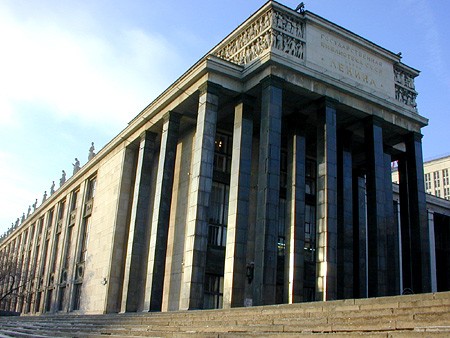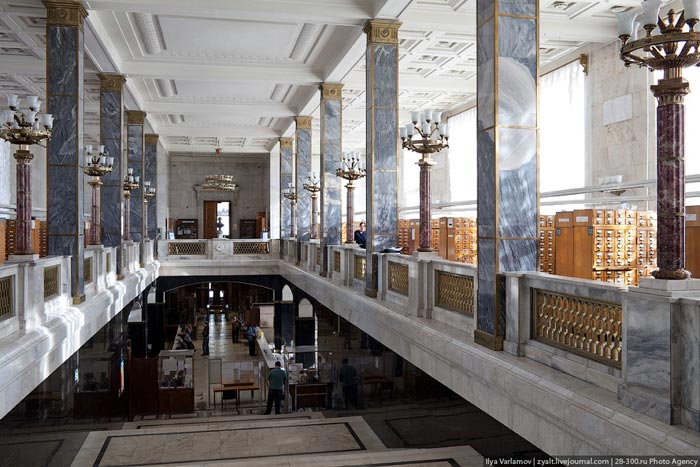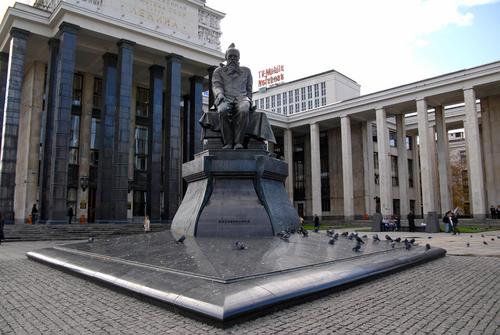
Russian State Library
The first and largest public library in RussiaMoscow is rightfully considered the city of libraries. The city is enveloped by a library network of different levels and subordination. It is here we find the largest library in the country - the Russian State Library (formerly the V.I. Lenin State Library of the USSR, nicknamed the “Leninka”).
Sergei Petrovich
Rumyantsev
-
29 710
items
The Rumyantsev
collection,
the primary library
collection -
44 800 000
items
Size of the
RSL collection
in 2013
The RSL collection traces its roots to the Rumyantsev family collection. Over the years the family worked towards the creation and development of a publically accessible museum and library.
-
x9
The archive is equal
to 9 football fields -
275 km
The overall length
of RSL bookshelves
is about 275 kilometers -
79 years
It would take a person 79 years
without sleep to have a quick, one minute look at each item in storage
In the beginning of XIX century the building which was the predecessor to the St. Petersburg RSL belonged to Sergei Petrovich Rumyantsev. On January 3, 1828 he received a letter from Emperor Nicholas I containing the following:
“Count Sergei Petrovich! I was particularly pleased to learn that following the promptings of your zeal for the welfare of the public, you intend to transfer the Museum, belonging to you and famous for its precious collections, to the Government in order to make it accessible to all and thus contribute to the enlightenment of the public. To express my goodwill and appreciation for this gift, offered by you to science and the Fatherland, and wanting to preserve the memory of the founders of this beneficial institution, I have ordered it be named the Rumyantsev Museum.”
In 1861 the museum was transferred to Moscow. The museum was founded on July 1, 1862 when Emperor Alexander II approved the ‘Policy on the Moscow Public Museum and Rumyantsev Muzeum’. It was the first public museum in the country containing the first free public library in Moscow.
-
5000 readers
1870visited the reading
hall in 1870 -
107 058 readers
1915visited the reading
hall in 1915
The museum is located in the most beautiful architectural ensemble in Moscow, the original capital of the Russian State, in the Pashkov house. J. Richter, a German traveler of the XVII century, called this building a magical castle.
All literature published within the nation made its way to the library. Gifts and donations also became an important source in expanding the collection. Muscovites brought their valuable collections to the first public library in the capital. Within a year and a half of its creation the library collection already consisted of 100 thousand items.
-
Lev N. Tolstoy
-
Fyodor M. Dostoevsky
-
Anton P. Chekhov
-
Vladimir G. Korolenko
-
Kliment A. Timiryazev
-
Dmitry I. Mendeleev
-
Konstantin E. Tsiolkovsky
Today, the library maintains permanent relations with international professional organizations. The Library Assembly of Eurasia (BAE), which makes it possible to exchange information with the other libraries in CIS countries to promote mutual informational and cultural exchange, was created and successfully operates on initiative of the RSL. Moscow’s "Leninka" is the headquarters of the Library Assembly of Eurasia.
-
Library Assembly
of Eurasia (BAE) -
UNESCO
-
International
Federation
of Library
Associations
and Institutions
(IFLA) -
International
Organization
for Standardization
(ISO) - Libraries
around
the world
All citizens of Russia or any other country, provided they are a student of a university or at least 18 years of age, can register with the Russian State Library.
-
200 new readers
About 200 new readers
register with the RSL daily -
4000 people
Almost 4,000 people
visit the library every day









